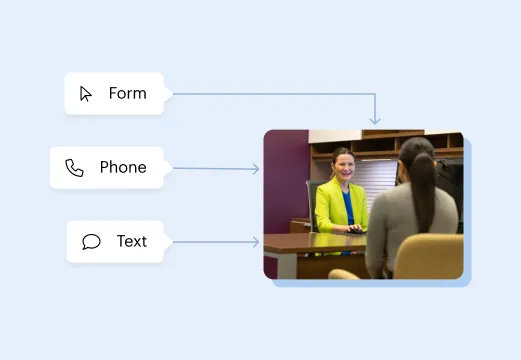Results may vary depending on your particular facts and legal circumstances. The attorney featured above is licensed in Florida. For a full list of attorneys in your state please visit our attorney page.
Car Wrecks in Kentucky
Car crashes can derail your life. We've helped thousands of people recover—physically, financially, and emotionally—after an accident.
Results may vary depending on your particular facts and legal circumstances. The attorney featured above is licensed in Florida. For a full list of attorneys in your state please visit our attorney page.
Kentucky Personal Injury Lawyers
We’re proud to fight for our neighbors. Meet the attorneys from your community.
100,000+ Five Star Reviews
The reasons why clients trust Morgan & Morgan.
Based on select nationwide reviews.
Results may vary depending on your particular facts and legal circumstances.
Our Results
Results may vary depending on your particular facts and legal circumstances.
How It Works
Focus on your recovery. We'll take care of the rest.

Submit your free evaluation
Start your claim

Meet your legal team

We fight for more
Results may vary depending on your particular facts and legal circumstances. The attorneys shown in these photos may not be licensed in your state. To find an attorney licensed in your area, please visit our attorney page.
Local Care
Backed by America’s Largest Injury Law Firm.
$25 Billion
Recovered for clients
nationwide700,000+
Clients and families
served1,000+
Attorneys across
the country1
Click may change your life
The attorney featured above is licensed in Florida. For a full list of attorneys in your state please visit our attorney page.
Results may vary depending on your particular facts and legal circumstances.
Learn More
Injured and not sure what to do next? We'll guide you through everything you need to know.
Get answers to commonly asked questions about our legal services and learn how we may assist you with your case.
Is Kentucky a No-Fault Insurance State?
Kentucky is a no-fault insurance state, but with an important caveat. Residents of Kentucky who own vehicles can opt out of the no-fault insurance system if they want to have the capability to pursue a lawsuit against another driver. However, this choice makes them vulnerable to getting sued right back should they cause an accident. This is known as "choice no-fault" car insurance.
Vehicle owners that elect for choice no-fault car insurance must do so in writing and submit the form to the state's Department of Insurance.
Other vehicle owners that go with the traditional no-fault system must purchase personal injury protection insurance (PIP), which pays up to $10,000 for medical bills, lost wages, and other out-of-pocket costs associated with the accident. Drivers can purchase PIP insurance with higher benefits for an additional cost.
In Kentucky, it's not just the policyholder who is covered by PIP insurance. Passengers and drivers are also covered, and pedestrians or cyclists that get hit by the vehicle are likewise covered for injuries.
Are There Injury Thresholds for Kentucky's No-Fault Insurance Laws?
In the event of serious injury, people harmed from car wrecks in Kentucky can still go outside of no-fault insurance laws even if they went with no-fault insurance coverage. For example, in an accident that results in $1000 worth of medical bills, a fracture of a weight-bearing bone, compressed, compound, or displaced fracture of any bone, permanent disfigurement or injury, or permanent loss of a bodily function also excludes injured parties from the no-fault insurance system.
What Is Comparative Negligence Under Kentucky Law?
If you opted out of no-fault insurance or if your accident was severe and you take your claim to trial, you will be subject to Kentucky's comparative negligence laws. This means that if you had any part in causing the accident, any award you receive would be adjusted to reflect your burden of fault. For example, suppose the jury awards you $200,000 for your injuries, pain, and suffering. Still, you were judged to be 30% at fault for the accident. In that case, you would only be entitled to collect 70% of the award, or $140,000. The percentage of fault you are assigned is subtracted from the total amount of the award.
An insurance adjuster will also use the concept of comparative negligence to guide them when evaluating your claim.
How Is Vehicle Damage Handled in Kentucky Car Wrecks?
Like many other states that follow no-fault insurance law, vehicle damage is not included. Individuals that have been in a car wreck could pursue damages against the other party if they were at fault for the accident by filing a third-party insurance claim. Suppose you drove a high-end vehicle that exceeds the at-fault driver's policy limit. In that case, you could consider filing a lawsuit for the uncovered portion. We may be able to help.
What Is Kentucky's Statute of Limitations for a Car Accident?
Every state has statutes of limitations that enforce a deadline for filing legal claims against other parties. In Kentucky, you have just two years from the date of the accident or two years from the last PIP payment from your insurance company to pursue an action against another individual that caused your accident.
Unfortunately, once this deadline is passed, you'll almost certainly be barred from pursuing any legal action. However, there are some exceptions. For example, suppose you were under the age of 18 at the time of the accident. In that case, the time clock doesn't start running until you've reached 18, regardless of when the accident occurred. Another occasion is if you've been diagnosed with a mental disability. In the instance of a car wreck, a mental disability could result from a traumatic brain injury. In such a case, the deadline does not begin until the disability is lifted.
In the event of a wrongful death caused by a car accident, the deceased's personal representative has one year to file a wrongful death claim from the time they are appointed in probate court. Lastly and critically, a claim for loss of consortium must be filed within one year from the date of the accident.
While you may have your reasons for delaying a legal claim, it's vital to contact one of our personal injury lawyers sooner rather than later to ensure you're able to recover compensation.
Why Is Kentucky So Dangerous for Drivers?
Rain - Kentucky gets about 48 inches of rain per year. That's ten more inches than the average for the U.S. Such a significant amount of rainfall is concerning. Kentucky is rated as the third most dangerous state for traveling in inclement weather. Slippery roads can occur because of rain, snow, and even roadway spills. Drivers can reduce the chances of an accident by observing simple safety rules such as:
- Checking the vehicle’s brake system regularly
- Checking tires regularly (worn tires should be replaced as newer tires have a greater capacity to grip the road)
- Maintaining a safe distance between you and other drivers
- Stay vigilant while driving to recognize black ice and dangerous flooded conditions
- Apply brakes and gas pedal gently to prevent a loss of control
- Avoid slamming on the brakes in the event of a skid-instead, take your foot off the gas pedal and gently apply brakes until the vehicle has slowed
Curvy, winding roads - Kentucky is known for rolling hills. While they can be fun to drive on, curvy roads, especially if on highways, introduce a number of dangers. Here are some tips to keep safe on Kentucky's winding roads:
- Limit the amount of steering to reduce the directional change of your tires-this makes tires less prone to skidding out of control
- Be sure to stay in your lane while turning left
- Obey all posted speed limits and road signs
- Avoid passing other cars on a curve because you won't have adequate visibility to spot oncoming traffic
- Slow down while approaching a curve and keep speed low until out of the curve
Construction zones - Driving in construction zones should always be done with care. Not just for you but for construction workers and other drivers who may be confused by changes in their day-to-day commute. Always pay attention to construction worker signals along with the following:
- Take care when merging with other traffic in the construction zone
- Minimize distractions such as talking with passengers, changing radio stations, eating or drinking
- Consider taking a detour to avoid the construction zone
- Obey temporary speed limits and other traffic signs
- Avoid trying to overtake other vehicles
- Don't follow other drivers too closely in a construction zone to avoid rear-end accidents
Poor visibility - Weather conditions such as rain, snow, fog, or even forest fires can cause serious issues with visibility. If you find yourself in these conditions, consider the following:
- Turn headlights on but avoid high beams as this can negatively impact motorists who are in front of you
- Do not use hazard lights unless its an emergency because it makes turn signals ineffectual
- Stay in one lane if possible to minimize the chance of hitting other unseen vehicles and vice versa
- If visibility is extremely poor, try to find a safe spot to wait it out
Traffic - Getting stuck in traffic jams is not only aggravating, but it's also dangerous. This is particularly true when other drivers start getting aggressive. Here's what you should do to decrease your chances of an accident:
- Stay calm and patient even when other drivers show angry behavior
- Maintain distance between your car and the one in front of you to minimize the chances of a rear-end collision
- Use signals when changing lanes and give other drivers time to see your signal
- Stay aware of other vehicles around you, even while driving at low speeds
When driving in Kentucky, as a general rule, slowing down can significantly reduce your chances of getting into a car wreck.
Car Wrecks in Kentucky: What Kind of Damages Can I Be Awarded?
Damages are a legal term for expenses or compensation. When you're in an accident that wasn't your fault, you're entitled to recover payment for your losses, whether it be economic or non-economic. Economic damages are for specific expenses that typically have a price tag associated with them, such as medical expenses and property damage. Non-economic losses cover "injuries" that don't have a specific dollar amount tied to them, such as pain and suffering. Here are some examples:
Economic damages:
- Medical expenses, past, and future
- Lost wages and lost earning capacity
- Damage to your vehicle or other personal belongings
- Modification to your home to adapt to disabilities
- Home care
- Travel expenses for medical care
Noneconomic damages:
- Pain and suffering
- Mental anguish
- Loss of enjoyment of life
- Inconvenience
- Loss of consortium
Working With Morgan and Morgan's Personal Injury Lawyers
No-fault insurance laws often make people think they don't have much choice after car wrecks in Kentucky. However, that's not always the case, especially when it comes to traumatic injuries. We've proven time and again that an insurance company's final and best offer isn't the end of the road. That's because we're not afraid to take them to court to ensure our clients get what they're owed.
While our negotiation skills frequently result in favorable settlements, you need a lawyer that is prepared to take your case to court if that's what is needed. We find that our court cases often lead to awards that are as much as twenty times more than what was offered pretrial. We strongly believe that juries are a far better judge of what our client's injuries are worth. That's why we push when we see the insurance company is not negotiating in good faith.
It doesn't cost you any more to work with one of the leading law firms in the country, so why wouldn't you want the best legal representation possible? You don't owe us a dime unless we win. Contact us today for a free case evaluation.










































